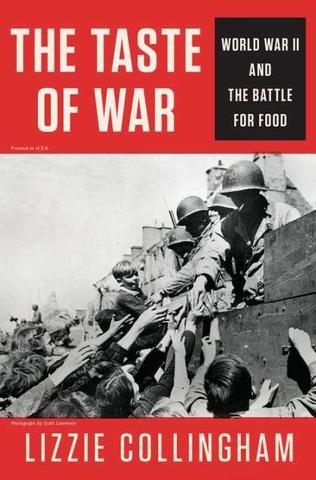The Taste of War

When it comes to the Second World War I have read countless books, prowled through any number of libraries and archives, and spent more time with my nose in primary sources or journal articles than I probably care to remember. Accordingly, to read Lizzie Collingham's book The Taste of War and have more than one eye-opening experience of revelation and wonder is quite a remarkable experience. But that is exactly what The Taste of War has done in terms of providing even the well-read with not just one or two; but any number of truly unique and revelatory insights on one of the most well-documented and studied events in human history.
Even more than the collection of new insights that come with The Taste of War is, however, the book's equally stunning achievement of providing all readers, including those for whom the Second World War is something of an obsession, with a brand new conceptual framework for approaching food's central role in the events that not only led to world war but also decided it. As so ably pointed out by Collingham; more people died of malnutrition, starvation, or other related diseases than on any of World War II's horrifically blood soaked battlefields. Again and again Collingham masterfully shows just how important food, the control of food, access to food, and the supply of food was to the major combatant nations of World War II. If for no other reason than this Collingham has produced a work that should be an essential building block in any future history looking at understanding how and why the Second World War began and ended as it did.
That said, and even better, The Taste of War is not just a sweeping strategic big picture look at nutrition, mass agriculture, industry, and logistics as related to the provisioning of food. It also dips into detailed and highly illuminating first person accounts of the role played by food on the battlefield, in the factories, in the fields, in the prison camps, and virtually every other corner of the globe touched by World War II. To that end it must be said that it should be no surprise to the well versed student of the war that food was a crucial element in Nazi policy, particularly regarding Eastern Europe. Nor should it be a surprise to anyone to find that Japan was woefully unprepared to maintain and defend the maritime empire it found itself in control of by the middle of 1942. And it is no great surprise to read this book and find that in the first two years of it's war against Nazi Germany the Soviet Union's war effort came dangerously close to collapse in part because the Wehrmacht captured the Soviet Union's most important agricultural regions, causing genocidal levels of starvation. But where the real strength of the book lies is the details that flesh out even these already well established facts and help to provide a smooth, free flowing narrative interspersed with first person accounts that time and again brings the reader back to the book's central thesis surrounding the centrality of food in each combatant's wartime economy:
"But the winter of 1942-43 did not mark a turning-point in the Red Army's food situation. A theatre manager, who was an officer during the war, explained to his Harvard interviewer 'after Stalingrad, we had no products or food for our men...Our soldiers only had cabbage to eat.'....The soldiers became expert foragers....Soviet soldiers would often stave off scurvy by making a foul brew of boiled pine needles, rich in Vitamin C....In 1941-42 the civilian sector of the economy virtually collapsed....Victor Kravchenko....described how in the first winter, as the Germans approached Moscow, the city '....was hungry, frostbitten, pockmarked by enemy bombs. It seemed broken in spirit and almost too weary to despair. Its people...dragged themselves from frozen homes to labour long hours...the official rations were barely enough to sustain life....'.....Irene Rush and her friends scraped by on a peculiar assortment of substitute foods. A friend made up food packages of throat pastilles, cough drops, and 'some horrible "sea cabbage" that looked like grey-green chaff and tasted like concentrated iodine.'...The Muscovites sat huddled in their apartments...The bodies of people who had collapsed from hunger began to appear on the streets....At the beginning of 1942 the fate of the Soviet Union looked bleak. No contemporary observer would have confidently predicted that the Soviets would not only hold out against the Germans but eventually be crucial in bringing about their defeat."
Again and again The Taste of War engagingly links food's role to the world's economies, armies, and political aims of its most powerful nation's in the first half of the twentieth century. It is a wonderful addition to the current literature on the Second World War, and should be on the bookshelf of any serious student of the war.



Post new comment